
This site is intended to report places where prone wave riding occured before the boogieboard? Next to bodysurfing, riding prone on a wave is one of the most elemental forms of surfing where the rider is immersed in the wave. Once the boogieboard became popular it dominated the prone surfing world, to the extent that other forms of prone surfing largely disappeared and subsequently largely acknowledged in surfing histories. Shorter boards able to ride waves more difficult to surf on old style longboards and legropes also contributed to prone surfing declining, as spots favouring prone surfers became more accessible. Kneeboarding also became more popular in the late 1960s, influenced by films and footage of George Greenough.
No doubt there are places not mentioned on this site, which offers possibilities of adding additional locations. The focus is on wood or fibreglass boards, rather than surf mats which have their own story. The term bellyboard has been used as a general term and paipo or papa paepo'o to specifically refer to Hawaiian boards. However, paipo is a term that has been applied to a range of different type of boards, and the terms bellyboard and paipo are often used intechangeably.
 |
Thin wooden barrenadores were ridden in Argentina from around the late 1950s. Edwin Salem advised boards like the one below from Villa Gesell, were available in sports stores. Sometimes boards were customised by painting on designs and occasionally by adding fins. A discussion regarding these barrenadores can be found here: Juan Di Nenno - Mi primer tabla de surf 50 AÑOS DE SURF Facebook page. Antonio Buendía advised that after the introduction of surfboards around 1964-65 that these boards were less frequently seen.
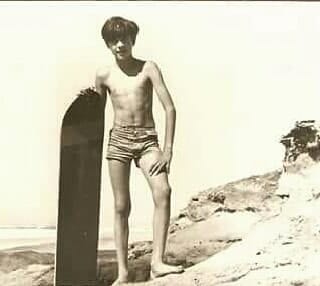 Juan Di Nenno, 1968 (source:50 AÑOS DE SURF) |
 A "tablas de barrenar olas" from Villa Gesell. |
These boards were commonly ridden using flippers. Lucas Grossi has advised "barrenar is closer to surfing as a concept where you can use a number of ways of doing these (i.e: body surfing, body board or surf board) but it's most popular use is when addressing someone on a bodyboard".
A photo reported to be taken at Coolangatta in 1912 depicts a woman holding a simple rectangular board. Wooden bellyboards seem however to have been used much more widely in the colder waters of Victoria. They were used by both locals and holiday-makers, who used guesthouse boards. Use of wooden bellyboards seem less common in the more populous state of New South Wales, where the surfoplane, which had been invented in the 1930s, was very popular. Bellyboards were known by a variety of names, including chestboard and the particularly Australian name: lamaroo (also spelled lameroo, loomaroo, lumeroo). The origins of this latter term are unkown, but has been used to refer to boards ranging from the UK style bellyboards to 1950's balsa twin-finned bellyboards (a style influenced by US surfing movies but also the visiting 1956 US-Hawaiian lifeguard team). Visiting surfers to Hawaii also brought home paipo boards, which some enterprising locals like Jamie Farfor went on to make and sell their own versions. There is limited information about Indigenous Australian surfing waves. An interesting snippet is this 1950s US documentary hosted by Ray Forrest, which shows a young boy riding a shorebreak prone: Arnhem Land
For photos and information on pre-1950s bellyboards, see: Australia pre 1950 These boards were usually ridden in the shallows by pushing off the sand.
 Ivy Russell, Jimmy White, Frederick Russell and friends at Cowes beach, 1934 Photograph Museum Victoria collection. |
 Early bellyboards. Photo courtesy Bob Smith. |
The advent of fins allowed for surfer larger waves on both wooden and fibreglass boards. During the 1960s a range of bellyboards were made, ranging from boards made from broken longboards, boards that looked like short versions of longboards, Dick Ash's bellyboggers and various single as well as twin-finned boards. In addiition to the boogie board, another factor that impacted on bellyboarding and which was confused with bellyboards, was the influence of George Greenough's surfing. A number of surfers who were interviewed, described this as a major influence, progressing from prone to riding kneeling. In the 1960s and early 1970s kneeboards were even refrred to as bellyboards and intially resembled bellyboards.
 Coogee 1962. The Australian Women's Weekly, 30(18). Photo by Keith Barlow. |
 Kit Carson, Winki Pop June 1969. Photo courtesy Jeff Callaghan. |
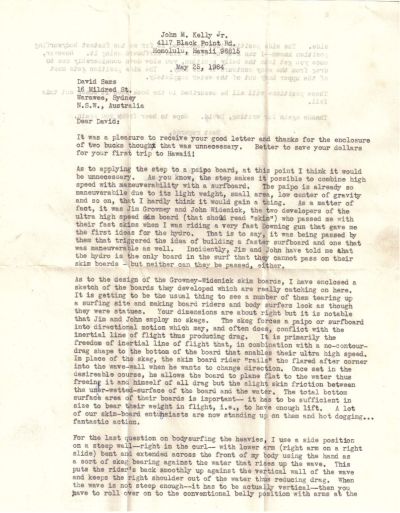 1964 letter from John Kelly (Hawaii) to Dave Sams. |
 Kit Carson, Jeff Callaghan & Robert McDermott, Kirra 1965. |
For information people who rode these boards, see interviews with Australian bellyboard riders hosted on mypaipoboards.org
Information on bellyboards can be found in these interviews with: Dave Andrews, Dick Ash, Pete Berry, George Bills, Jeff Callaghan, Kit Carson, Lewis Cawsey, William "Bill" Clymer, Tony Dawes, Paul Gannon, Bryan Hayden, Robert Hosking, Dr. Barry Hutchins, Dave Jackman, Peter Kidman, Joe Larkin, Kevin McManus, Dennis Markson, Ian Peden, Mick Potter, Barry Regan, Bob Rose , Dave Sams, Gordon Simpson, Pete Sobels, Col Taylor and Leigh Tingle.
More recent experiences are recounted by Brett Curtis, John Kovar, Paul Witzig and Tom Wegener.
 1950s Twin fin. Photo John Harper. |
 Barry Hutchins riding at Yallingup. Photo by: Clay Bryce. |
 1960s McDonagh design twin fin. Photo by Craig Hosking. |
 Dick Ash bellybogger. |
See Magazine articles This link takes you to several articles from the 1960s and more recent articles on Australian bellyboarding.
Sallly Parkin an English bellyboard rider and manufacturer recalls that on a trip to Barbados in 2018, meeting a man who reported surfing wooden bellyboards in the 1960s. The wood board in the photo below, is likely to be similar to the prone boards.
 Plywood surfing, Barbados, circa 1988. Photograph by Dave DiGirolamo. No quite a barn door, but close. Surfer, Volume 29 Number 12 page 113. Source Surfresearch site |
Bellyboards have been ridden in Brazil since the 1940s. Luiz "Ted" Pereira has advised, "My father was a belly surfer in the 1940s, and there were no fins yet. According to him they were made of plywood by a bloke in his neighborhood, Leme (an extension of Copacabana Beach). Those first boards had a brand-name, Jacaré, (alligator in Portuguese). Pegar jacaré means to catch alligator. The expression came before the brand-name wooden board from the 1940s. Swim fins arrived in the late-1940s, and the Jacaré evolved to have a slightly curved upwards nose and hand slots on the sides. The latter were made by a factory. They began to disappear in the late-1950s". Reinaldo Andraus advised: ' "Pegar jacaré" means in Portuguese, the act of surfing waves. Because your body in the water looked like an alligator... In my opinion "pegar" = "get" and "jacaré" = "alligator" or, to surf a wave with your body stretched as long as you can. I usually referred to "pegar jacaré" if I went body surfing and "surfar de prancha" if I were using my little alaia wood board'. Telmo Moraes Teixeira Filho from the Cabo Frio surf museum similarly commented that "pegar jacaré" referred to boards being ridden prone, "hence the expression alligator surfing, laying with eyes out" Reinaldo advised that bellyboards were also called prancha de madeira and could be bought in stores that sold items for the beach. His board was about 36 x 12 x 1/2 inches with rocker in the nose area, with two handles near the rails. The handles were used to carry the board or hold on to the board in the shorebreak, but not when surfing the board.
Otavio Pacheco recalls riding a wooden body board, called an "Oceania," from around 1958 or 1959 until 1963, when he started riding a madeirite, before progressing to a fiberglass São Conrado longboard in 1966. "Oceania was very popular and we used to buy them in the sports shops. Oceania was also the brand of the factory of the boards, and many others products. It had 2 little rolls in the rails, but we didn't use them because we used to hold the nose with the hands to get more speed. It was about 36 inches long and 18 inches wide with a lots of curve in the nose and usually they were painted." Tito Rosemberg has recalled riding a Balnea brand board, a board that sold in a store on Santa Clara Street.
 Reinaldo Andraus with 3' x12" board. Photo by Photo by Silvia Winik. |
 Beira-Mar", 28 de Outubro de 1939, n. 656, p.20. Bibliotecha Nacional Digital Brasil. Courtesy of Paulo Donadio Baptista O deslisador. Sorri, lembrando -se do prazer de deslisar sobre as ondas , como em Hawaii "I smiled, remembering the pleasure of gliding over the waves, as in Hawaii". Both flat and curved nose boards are evident in this photo. |
For accounts of riding these boards and other background see: Luiz Pereira interview
Surfar e´ coisa de Rico - Filme Completo In this film at 09:31 you can see the plywood maderites being ridden, prone, kneeling and standing. There is also another example of a 1960s wooden bellyboard at 09:49.
 Screenshot from 'Surfar e´ coisa de Rico' |
 B Screenshot from 'Surfar e´ coisa de Rico' |
Riding bellyboards on Jersey and Guerney have a long history. Jeremy Oxenden advised that his grandfather Nigel 'Oxo' along with Msrs.Martin and Gordon started the Island Surf Club of Jersey in 1923. Nigel had been exposed to surfing in Hawaii and South Africa. Initially boards were 5' and made from tongue and grove flooring. Nigel's board featured a leash made from sash window cord which he would tie to his belt and his the board by a metal loop on its tail. Jeremy recalled grandmother Pat, his father, family and friends also riding bellyboards. One of these friends, Archie Mayne lived in Egypt for some time after WW2 , where he surfed there with one of his daughters before moving to South Africa in 1952.
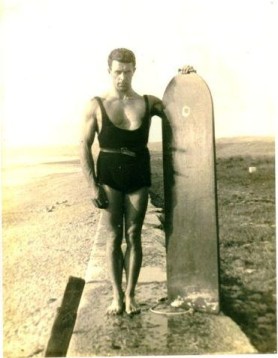 Nigel 'Oxo' Oxenden with one of his boards, ca. 1923. |
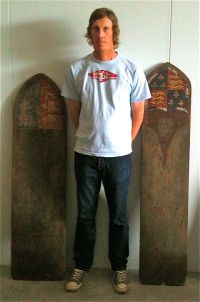 Jeremy Oxenden with Nigel's board on his right and Archie Main's board on his left. |
 Pat Oxenden at St Ouen's Bay sea wall late-1940s. |
 Pat Oxenden surfing at St Ouen's Bay. |
Bellyboards or surfboards as they were known, have a long history of continued use in England, especially in Cornwall and Devon. A distinctive aspect of bellyboard use in England is that it is the one place in the world where the use of wooden bellyboards were so widely embraced, by young and old, men and women. There has been an annual world bellyboard championships since. Despite cold water, many contestants don't wear wetsuits and are over 60 years. Boards ranged from the early flat coffin lids to single piece ply boards, with nose rocker produced by use of steam or immersion in boiling water and rocker created by use of rope and a ladder.
A short account of British bellyboards written by Sally Parkin of Traditional Surfboards.
 Coffin lids, Perranporth circa 1920s. Photo courtesy John Heath. |
 Women riding a wave. Photo courtesy Alex Williams. |
There were a large number of different manufacturers. Shutterbug Photography and Sally Parkin provided many of these names - Bickers who made the Headland Hireboards; Bilbo who may have also prduced Smile and the Newquay Surfrider; Cavendar and Clark who made Granta Folding boats bellyboards; Crest; Eagle surfboards; Gilcraft who made Aquathrill; Grays of Cambridge; Charles/Dick Pearce; Gerald Pearn Ltd who made Bondi Seahorse; Lillywhites made by Grays of Cambridge; Nympyh Surf Jockeys; Prout of Essex; Solarbo from West Sussex who made Kon-tiki; Wavemaster; Woodward Skimmer and Yeo who made boards for other brands, not under their own label. Malcolm Yeo worked at his Uncle Bert's factory during his school holidays. He advised the company took delivery of 500 plywood sheets 2 or 3 times a year. Eight boards could be made from one sheet which equates to about 10,000 boards a year. The original parallel-sided boards were noted to give way to tapered models. The mass produced plastic bodyboards saw the demise of the business. Source: Yeo's Bellyboard factory There continues to be several manufacturers of bellyboards, which range from simple ply boards to laminated composite boards.
 English bellyboards. Photo courtesy Matt Cooper. |
 English bellyboards. Photo courtesy Matt Cooper. |
For first person accounts with English bellyboard riders see: Paipo interviews on mypaipoboards.org John Heath, Sally Parkin and Richard Whiting ride traditional English bellyboards while a more modern take comes from Andy Bick and Keith Usher. Fibreglass bellyboards were also made, such as Tau and harmony, from the 1970s-1990s, but traditional wooden boards have retained their popularity.
 Ronald S. Funnell's book was first published in 1934 and re-published in 1953. |
 This brief guide was printed by Charles Pearce and son, early 1960s. |
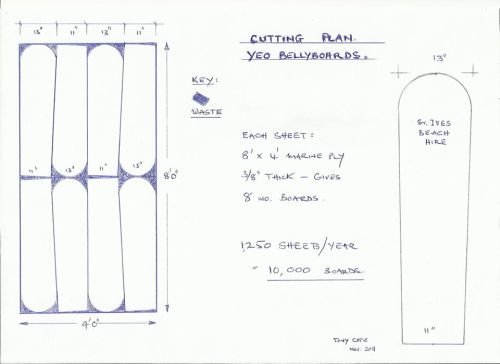 8' boards to a sheet. Drawing by Tony Cope, based on the account of Malcolm Yeo. |
 Early surf school. Photo courtesy Sally Parkin. |
Historical accounts from Fiji are mixed. Alexander (1911) described diasppointment at not being find Fijians surfing like he had experienced in Hawaii: After witnessing a display by women and old men (the younger men were away working) on Taviuni, he wrote: " Alas! to my disappointment, I found that the Fijians, unlike the Hawaiians, use any scrap of timber as a board for surfing; moreover, they never stand upon their boards, which are usually but two or three feet in length, being content to merely rest their chests upon them and come sweeping in before the waves in a prostrate position". In contrast, Walker (1910) described seeing women put on a display of surf-board swimming for him and noted: "I had seen the natives in Hawaii perform seventeen years before, but it was tame in comparison to the wonderful performances of these Fijian women on this dangerous rock-girt coast".
See: Water Sports of the South Sea Islands by H.F. Alexander and Wanderings Among South Sea Savages and in Borneo and the Philippines H. Wilfrid Walker.
There are accounts of pre-1950s surfing in France, however the most well-known board is the planky. The French planky has been attributed to the inventive Georges Hennbeutte. Alain Gardinier, in 'Les tontons surfeurs: Aux sources du surf français' (2004) cites Hennebutte's nephew Claude Durcudoy: "In the 1930s, George Hennebutte had the idea of following a wave with a board. Thus was born plancky. With a friend, George went to the store Biarritz Happiness (today Galeries Lafayette), retrieve the plywood that was used to wrap the fabric. As they were flat, the pair moistened one of the two ends are then placed counterweight to give a curve. Then they improved the process. ' Gibus de Soultrait (2012) met Hennebutte in the 1990s and was told a similar account but added that the nose-lift idea came from a ski and that at the time the planky became a means to enhance the Biarritz bodysurfers wave riding. These plywood boards were commercially made in presses and used around the Biarritz area, especially Plage Miramar. Pioneer board maker Jacques (Jackie) Rott reported first seeing a planky in 1947 and began making them in 1952. Rott's planky's were 5 ply and about a metre long. Sosthène Larcebeau was another manufacturers of plankys. Planky's were advertised in the first edition of Surf Atlantique (Surf Atlantique 1964) along with a skimboard, both sold by the company Epiland. Rott reported ceasing production because he couldn't compete with large companies. In addition to commerically produced boards, there are examples of homemade boards. For more information see The French planky
 Jacky Rott with his blue planky and the board used as a mold Photo Philip Zibin. |
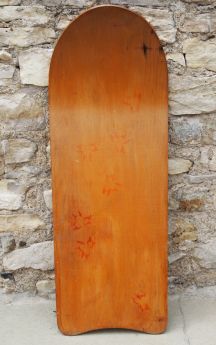 Sosthène Larcebeau planky, c1960. 98 x 36 x 0.8cm Photos courtesy Gérard Decoster. |
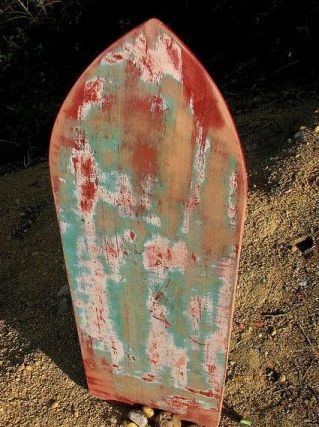 1952 plywood bellyboard: 100cm 40cm resistant plywood. Photo courtesy Florent Palangié. |
 175 x 34.5 x 1.5cm board surfed by Julien Guilbert's father at Cap de la Haque in the late 1950s. Photo by Julien Guilbert. |
Information about plankys is also found in this interview with French shaper, Guilhem Rainfray
A 1949 article referred to Alexander's 1837 account of chiildren riding wooden boards at Acra. This account and others of surfing in West Africa are found on Geoff Cater's surfresearch site. Nineteenth century African surfing accounts.
 Ghana 1910. Photo by Capt. T.C Hincks Source: Paipos in the Media |
 Volta region 2018. Photo by Edwin Salem |
Kevin Dawson, author of Undercurrents of Power: Aquatic Culture in the African Diaspora wrote that he believed "bodyboarding was common wherever Africans used surf-canoes, which was most of Atlantic Africa (from Senegal to Angola), as well as South Africa. The few spots where it wasn't practiced was in places like Guinea (where mangrove trees grow on the shoreline and there's no surf) and possibly Togo and Benin, as people tended to navigate the huge estuary and not go onto the ocean, and the Niger Delta". he noetd that "I've seen clear accounts of bodyboarding in Ghana, the Ivory Coast, the Gambia, Senegal, Liberia, and Congo-Angola" and seen "traditional bodyboards in Ghana, the Ivory Coast, the Gambia, and Senegal". He recounted, "I have a couple friends whose grandfathers lived and worked in West Africa during 1950s and 1960s and their fathers told them how they'd ride traditional bodyboards with local kids".
 Endless Summer in Ghana. Images from Bruce Brone's movie courtesy Kevin Dawson |
The Hawaiian Islands have a long surfing history. It was only in the twentieth century, that the term paipo began to be used to describe wooden bellyboards. Typically finless, but not exclusively so, these boards were ridden prone, kneeling and standing. The Bishop Muesum on Oahu contains some examples of earlier, narrower boards. Traditional Hawaiian surfboards became the inspiration for Tom Wegener's championing of the alaia, which can be ridden prone or standing. Another information source are two 1906 movies produced at Thomas Edison studios and filmed by Robert Bonine: Panoramic View and Surf Scenes, Waikiki Beach, Honolulu, Hawaiian islands: Surfer Today website This shorter excerpt from Panoramic View and Surf Scenes includes slow motion footage of sections with likely bellyboards.
Wally Froiseth produced a twin-finned Pai Po board which featured a handle (a board style that became influential in Australia and the US) and John Waidelich and Jim Growney, developed a guitar pick shaped board that would be commercially sold by Val valentine, under the Paipo Nui label. Valentine who lived at Sunset Beach, was a filmaker who promoted the use of paipo boards through his films and magazine articles: Paipo Nui (1965) and It's Smaller, Faster and 300 years Old: The Paipo Board (1965). Paipo boards were simply made as well, from real estate signs or any other wood source and had been the first board surfing of many Hawaiians prior to the 1980s (for example, see Sam George's documentary - Hawaiian: The Legend Of Eddie Aikau). Many boards were made in school woodwork classes. The design, in modern materials are made by Paul Lindbergh, under the Hawaiian Paipo Design label. The advent of the Morey boogieboard saw the rapid decline in the number of paipo board riders. Jarrett Liu has been making a variety of board styles, which he refers to as Papa Paepo`o.
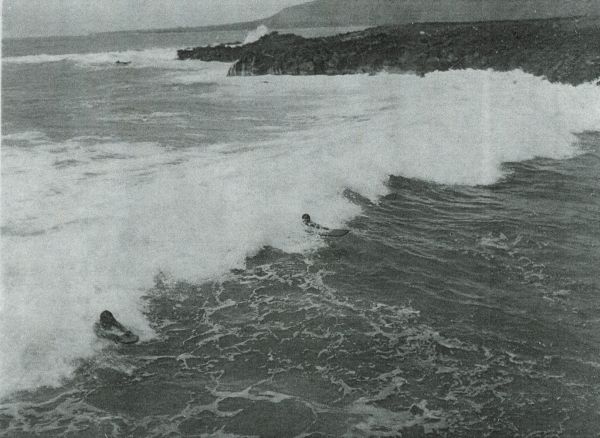 1910 prone surfing at Kawa on the Big Island. Photo courtesy of John Clark. The original photograph is part of the Bishop Museum collection. |
 Ben and Mila Finney, with John Clark at the Bishop Museum in 2010. The short board in the foreground is estimated to be about 4'. Photo by Bud Scelsa. |
 Bellyboard circa 1930's. Pine, redwood rails. Photo Pacific Coast Vintage Surf Auction. |
 Boys at Waikiki. The Moana Pier dates the photo 1901-1930 (John Clark). |
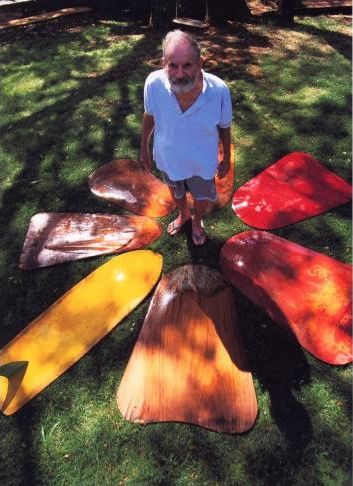 Paul Swanson with paipo boards belonging to himself and Val Valentine. Photo David Pu'u in The Surfers Journal 9#3. |
 Southside paipo board riders. |
Interviews with Hawaiian paipo riders Paipo interviews on mypaipoboards.org
Information on paipo boards and bellyboards can be found in these interviews: Devon Aguiar, Mike Broderick, Justin Bullock, John Clark, Jack Coberly, John Galera, Larry Goddard, Jim Growney, Ron Haworth, Paul Lindbergh, Buzzy Kneubuhl, Craig Matthew, Jack McCoy, Stan Osserman Sean Ross, Donny Roth, John Saul, Bud Scelsa, Charlie Schuster, Rainer Stegemann, Jerry Vasconcellos, Trevor Yamamoto and Steve Zane.
Other directions have been taken by Vinny Bryan, Gus Acosta and Gilbert Lum.
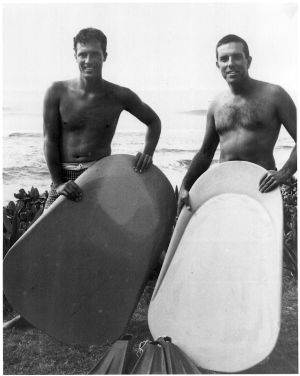 Jim Growney and John Waidelich with Paipo Nui Photo courtesy Jim Growney. |
 Portlock - 1965 - John Waidelich. Photo by Tim McCullough. |
 Paul Lindbergh - Hawaii Paipo Design. |
 Sean Ross. Photo courtesy Sean Ross. |
 Larry Goddard and Makaha Missile. Photo courtesy Larry Goddard. |
 Wally Froiseth and Bud Scelsa. Photo courtesy John Clark. |
 John Galera. Photo courtesy John Galera. |
 John Galera NoFins. Before the curve is put in the board, the planshape looks like a more traditional shape. |
 Jarrett Liu. Papa Paepo`o hands free. |
 Harry Akisada, body control. Photo by hawaiianline.com. |
 Ted Alexander at Sligo in the 1960s. Photo courtesy of Ted Alexander. |
Not much is known about bellyboard use in Italy. The two exceptions are a postcard from German tourists in 1906 and footage from a 1948 British Pathe newsreel, likely filmed at Monterosso (on the Cinque Terre) The boards in the newsreel are similar to that in the postcard, simple rectangular pieces of wood. For more information see: The planky in Europe
 1906 postcard addressed to Leipzig. Photo courtesy Charlie Spurr. |
 Italian Summer. British Pathe newsreel. |
Nobuhito"Nobby" Ohkawa has researched a tyle of surfing commonly known as 'Itago-nori', translated as 'floor board riding'. Reflecting the range of locations surfing occurred, itako were called "Itakko"at Oiso Kanagawa, "Setsukashi" at Niijima island of the Izu island chain, "Senoshi"at Yamagata North eastern Japan and"Sebuta"at Tokushima ShikokuItako were the removable floor boards from fishing boats. Children and adults used them to catch waves. Boards on Nobby's site range from 713 x 262 x 13mm to 1233 x 310 x 20 mm.
 Boat floorboards. Photo courtesy "Nobby" Ohkawa. |
 Oiso Museum display of itago boards. Photo courtesy "Nobby" Ohkawa. |
For more information, see: The itako Nobuhito"Nobby" Ohkawa's website
The oldest written description of itako is from a diary of Dokurakuann Kanri, a haiku poet who lived in Sakata. He visited Yunohama beach (north eastern Japan) in 1821. He wrote:
"Perhaps ten children of 12 or 13 are there
taking the boat's planks they go,
embarking and diving into the racing sea,
further and further out they go,
then riding the waves they come back to shore,
fast, like an arrow, so many times they go.
Nobby's web-site also contains details from how-to guides by Saburo Sato (1920) and Ikuo Tsuzaki (1914).
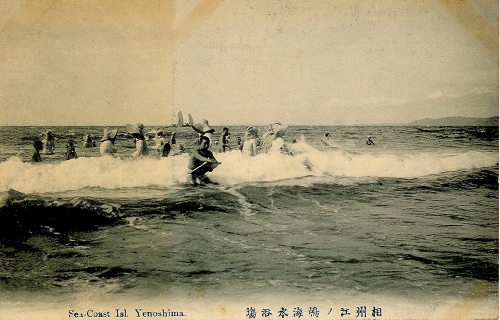 Itago rider. Photo courtesy "Nobby" Ohkawa. |
 Image from Library of Japan Physical Education instruction manual. Photo courtesy "Nobby" Ohkawa. |
John Clark demonstrating riding an itago
Not a location associated with surfing, nonetheless, there is a history of bellyboards being ridden in the Netherlands, which has continued to this day. Nico "Niek" Dekkers wrote to a friend in california to find out about making surfboards and received a fax back from the University of California
 1969 letter signed by Ricky Grigg |
 Gordon & Smith bellyboard. |
 Third design - the template for Niek's board. |
 Nico "Niek" Dekkers and Olaf de Vries - June 2016. Photo by Olaf de Vries |
 4'1" Ollywood bellyboard. Photo by Olaf de Vries. |
 Photo courtesy Sally Parkin. Circa 1920s Phoenix Brewery, Amersfoot, Holland. |
Prone surfing has a long history of use in New Zealand. The indigenous Maori surfed on small wooden boards (Best 1924). Surf riding (Whakahekeheke) was said to be practised in small canoes and on small boards. Both craft were referred to as kopapa (or a moki in the northern area). Best in his book, 'Games and Pastimes of the Maori' wrote:" The board, or piece of plank (also termed a kopapa so often used in this sport was about three feet long. Having gone out as far as necessary for the purpose, the performer threw himself lengthways on his board with his two hands grasping the front end thereof, just as a large, healthy wave overtook him. On this wave the rider was shot ashore to be left on the sandy beach by the receding wave, whereupon he would go out again to ride another in. This sport was indulged in by both youths and adults, including females, and one might see thirty or forty riders coming in together on a big wave. Sometimes a performer dispensed with the board and rode in on the wave with his arms stretched out before him". Te Haumihiata Mason advised: "The word 'whakahekeheke is a verb meaning to surf ride. 'Kua haere ki te whakahekeheke' 'means he's gone surf riding'. So does whakaheke ngaru - the word 'ngaru' means waves. 'Kua haere ki te whakaheke ngaru' literally means 'he's gone to ride the waves. The Maori word for a surf board is 'kopapa'and sometimes just 'papa'. The word 'papa'is also the word for a plank or a slab of timber. They're all related terms really in terms of language. Any sled or toboggan type thing would also have been made from slabs of timber or just a branch really, and in terms of sporting activities used to toboggan down hillsides, probably a practise much like the people of Rapanui have revived in recent times".
For images of surfing and boards, see: Bellyboarding in New Zealand. M¯aori times to the 1950s Paipo - Bellyboarding in Australasia
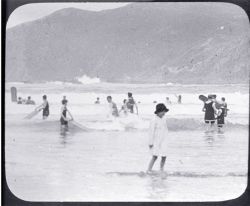 Swimmers in the surf, possibly at a Wellington beach. Henry Thomson lantern slide, circa 1900. File Reference CCL PhotoCD 3, IMG0010. Christchurch City Libraries. |
 Otaki Beach - 1926-1928. Photographer: Adkin, Leslie 26.12.1927. Museum of New Zealand Te Papa Tongarewa. |
The first known photos of surfing in New Zealand consist of lantern slide image from circa 1900. Subsequent photographs depict rectangular piece of woods, then flat boards with curved noses as in the late 1920s photograph. By 1937 nose lift is evident. The Tairawhiti Museum, Gisborne contains a redwood bellyboard with scooped deck (and scooped-fish tail), hired out by Gisborne surf club in the 1930s. The board was reported to have been given to the club by a surfer who had lived in Hawaii. Another more recent Hawaiian connection was the late Dave Jackman, a legendary Australian surfer moved to New Zealand in 1963. He had been exposed to the Paipo Nui style boards on trips to Hawaii and went on to ride a slightly, narrower and longer version. Peter White who had also visited Hawaii, brought back a Paipo Nui board, which he copied and sold to fellow members of the Muriwai surf club. Rocky Hall, another bellyboard rider had been exposed to bellyboards in Australia.
New Zealand from the 1960sPaipo - Bellyboarding in Australasia.
Interviews with New Zealand bellyboard riders Paipo interviews on mypaipoboards.org
 Dave Jackman letter 2011 on building a paipo board. |
 Dave Jackman board and mould. |
 Dave Jackman and Tony Butt, 2011. |
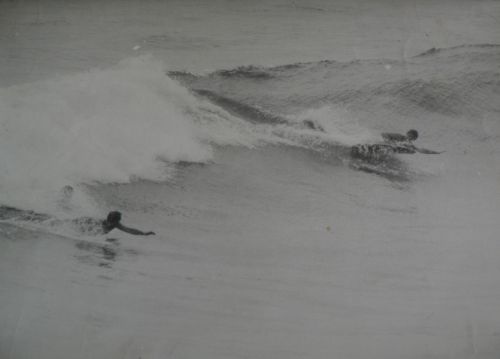 Tony Butt and Peter White at Muriwai - 1967. Photo courtesy of Peter White. |
 Peter White and paipo board. |
 Tony Butt and paipo made by Peter White. |
In a 2016 article, Magnus Endal described wooden boards being ridden around Madang. Referred to as "splinters" or "palangs" they were reported to have been ridden for decades. Plywood Surfing in Papua New Guinea is What True Surfing is About Magnus Endal. The boards made of plywood were rectangular in shape.
 Splinters in PNG. Riding style and kicking technique can be seen in these photos. |
 Photos taken by Magnus Endal. |
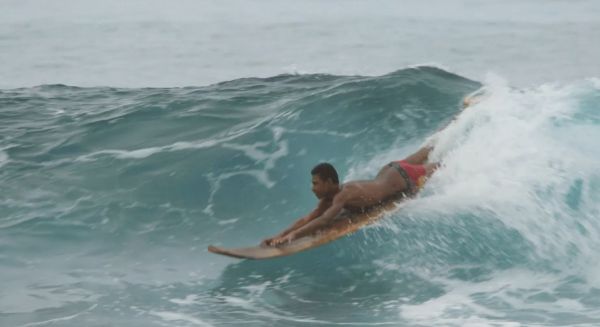 Haus Tumbuna Video post production Nicki Wynnychuk. |
 Haus Tumbuna Video post production Nicki Wynnychuk |
Peru has a long coastline and people for centuries have fished the seas and ridden waves. Pottery from the Chimu culture show figures riding waves, prone and kneeling. The reed Caballitos de Totora ridden standing up at Huanchaco are well known. The photograph below of adventurer Thor Heyerdahl, with young biys with small reed boards, suggests that children surfd prone before learning to stand up.
 Chimu pottery figure, 1100-1450 AD. Staatliches Museum für Völkerkunde München. |
 Small Caballitos de Totora with Thor Heyerdahl. |
Limited information is available about Portugal. A film shot in 1927 at the Englishmen Beach (Praia dos Ingleses) at Leça da Palmeira near Porto depicts a group of about 12 in the water, with at least seven people riding together prone on bellyboards. The film, Aspects of Leça da Palmeira, Matosinhos and Leixões was photographed by the Portuguese Army Cinematographic Service and located by the writer José Carlos Soare. João Macdonald has cited research by José Maria de Oliveira that there was a British community of approximately 90 residing in Leça in the1920s and that these bellyboard riders were probably from that community.
See: ASPECTOS DE LEÇA DA PALMEIRA, MATOSINHOS E LEIXÕES Full film
See: Leça beach, 1927: the first surfers in Portugal Excerpt from ASPECTOS DE LEÇA DA PALMEIRA, MATOSINHOS E LEIXÕES
See: Portugal
 Bellyboard riders 1927. |
 Source: ASPECTOS DE LEÇA DA PALMEIRA, MATOSINHOS E LEIXÕES. |
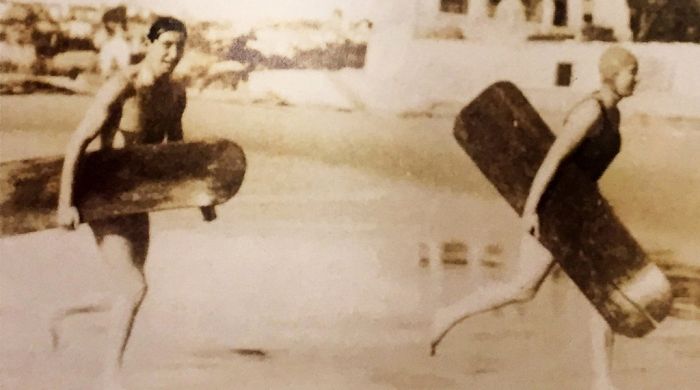 Tamriz 1934. British in Estoril. Photo courtesy Selecta Grego António Bossa. |
Between the 1890s and 1911 Augustin Krämer travelled around the Pacific on five occasions. His book, Die Samoa-Inseln (The Samoan Islands) contains a photograph of das Wellengleitspiel (fa'as'e), which is wave sliding or gliding. "fa 'ase'e das über die Wogen gleiten , auf Brettern oder in Booten (Stair ), ist , wie z. B. auch in Hawaii , ein altes Spiel. Es kommt darauf an, auf dem landwärts abfallenden Theil der auf laufenden Woge liegen zu kommen, so dass diese in rasender Eile das Brett mit sich fortträgt . Siehe Bild No. 43.
From the poem on the poem on Ti'eti'e i Talaga is the line: Se'e i le galu Ti 'eti 'eitalaga (slide on the wave, Ti'eti'e i Talaga). Arthur Pauli advises that Wellengleitspiel translates as wave + slide + play, playing on the waves by sliding on them.
Another account is that of William Brown Churchward (1887). He noted: "When surf swimming is indulged in, the bather wades out as far as he can go on the reef, sometimes quite a considerable distance, carrying with him a flat board about three feet long. On a suitable wave arriving, he throws himself on his chest flat on the board, and as the billow breaks over him is carried on its foaming crest with great velocity towards shore. Young people appear never to tire of this sport". My Consulate in Samoa A later account by Ella in 1897, in the (Journal of the Polynesian Society) reports that "A favourite sport of the young people is to ride over the surf of breakers on light floats of dried banana stumps". O LE TALA IA TAEMA MA NA—FANUA Rev. Samuel Ella.
.
 Das Wellengleitspiel (fa'as'e) Augustin Krämer (1902) Die Samoa-Inseln. |
In 2000 Sam George, Randy Rarick and John Callahan travelled to São Tomé, an island off the coast of West Africa. George described: "village kids who rode their local waves both on hand-carved bellyboards called tambuas, and on short goffe wood rafts, made specifically for riding surf-ski style".The islands of São Tomé and Príncipe were reportedly uninhabited until Portuguese navigators visited sometime between 1469 and 1471.
.
 2019 photo by Ji-Elle Wave play on a São João dos Angolares beach in São Tomé |
 2019 photo by Ji-Elle Jeux de vagues sur une plage de São João dos Angolares à São Tomé |
Roger Cox wrote an article 'Search for Scotland’s first surfer' in the Scotsman, published 12th Nov 2014. He interviewed Neva MacDonald-Haig (nee Gordon-Dean) of Drumnadrochit. Cox wrote :"MacDonald-Haig says that every summer from 1933 until about 1938, her parents Horace and Helen took her and her siblings Peter, Margaret and David on holiday to Westport, seven miles north of Machrihanish. “There was this wonderful beach and never a soul on it except us,” she says. “There’s a picture of us all in our swimming clothes standing beside a sign that says ‘this beach is dangerous for bathers’ – but there was no talk about surfers.
“My father stood with us beside the sea one day and we were admiring and listening to the thunder of these great Atlantic rollers and he said to us ‘you know, there’s nothing between us and America.’
“We used to try and ride the waves with our bodies but he said ‘I think we should get help to ride these waves’ and he went to the local undertaker. Now, it makes a good story to say they were coffin lids that we rode on but it’s an exaggeration, they weren’t really. The undertaker made these boards for us. I don’t remember his name, I’m afraid, but we’ve got one or two pictures of us actually in the surf using these boards. The modern surfboards are all pointed aren’t they? But these surfboards were rounded. The photos aren’t very clear but you can see the shape. They were probably about five or six-feet long.”"
 Gordon-Dean family at Westport. Photo courtesy of the Scotsman. |
A 1949 article by Jean Rouch: Surf-riding: Sur La Cote D'Afrique. Notes Africaines, documented the use of wooden bellyboards. The author noted use by the European community of Dakar, who surfed at Cambéréne, Yof or Madeleines beach. Riding these booards was also noted on the Basque coast of France. For a copy of the article see: Surf-riding: Sur La Cote D'Afrique Surfing in Senegal
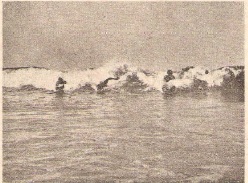 |
 Caption 2 |
Caption #2:
"3. Slip with small board
By contrast, if the swimmer is lying on a simple board (0.60 X 0.30 for example), the reaction R (Figure 4) vertical is much larger and allows the head (and often the chest) to be completely out of the water. Once the wave catches up, no further effort is necessary. The swimmer must simply be careful to direct the board (inclined before the surge, almost horizontal afterwards) he will be pushed to the shore. Furthermore, by inclining the board sideways, the swimmer is, to some extent, able to control its direction".
Practice this game in Africa We have seen this game in the village of Yof. It is practiced by young fishermen. They practice the first three movements, but especially sliding with the board. This is an old piece of wood, a barrel stave, or the bottom of an old canoe. Some boards have a transverse bar known as the "steering wheel" (FIG. 6). The most skillful ones use small boards and engage in "fantasies" (one elbow on the board as in the photograph). This game is called "Saran" (to slide). The natives tend to take only unbroken waves (which is much easier) and beat their feet almost all the time (which stops from the point where the wave is caught). This game has been played in Senegal for a long time. In St. Louis, in a rough sea, they are known to travel a few hundred meters. At Yof at high tide (the most favorable time) rides of 50 meters are common".
A 2009 BBC documentary, South Pacific contained footage of children surfing prone with canoe paddles on Anuta, in the Solomon Islands. Using canoe paddles is also reported in an account of Tahitian surfing by CaptainWilliam Bligh, 1788: "The heavy surf which has run on the shore for a few days past has given great amusement to many of the Natives, but is such as one would suppose would drown any European. The general plan of this diversion is for a number of them to advance with their paddles to where the Sea begins to break and placing the broad part under the Belly holding the other end with their Arms extended at full length, they turn themselves to the surge and balancing themselves on the Paddles are carried to the shore with the greatest rapidity."
 Boy from Anuta surfing on paddle. Photo from BBC South Pacific documentary 'Ocean of Islands'. |
 Boy from Anuta surfing on paddle. Photo from BBC South Pacific documentary 'Ocean of Islands'. |
For more details see: Surfresearch historical accounts
Steve Herbert of the Kalk Bay Historical Association has advised that Michael Walker in his 2009 book, Muizenberg: A Forgotten Story, reported an Australian introduced surfing to Muizenberg in 1910. By 1913, as a result of promotional campaigns, there were reportedly hundreds of bellyboards in the surf. In addition to Capetown, bellyboards were ridden at Durban and Morgan Bay, in the Transki. Bellyboards also featured the South African Surfer in 1967 and 1968. South African Surfer
 Muizenberg Bulletin - surfing. |
 This 1927 oak board was purchased at Muizenberg Beach by Lady Hoight, wife of the Provincal Governor for 17 shillings and six-pence. |
For information about South African surfing see the interviews with Derek Jardine and Maurice Richardson: Paipo Interviews. A more modern account is that of Charl Van Rensburg.
 The holes at the tail suggest a protective strip covered the tail. |
 Muizenberg Bulletin. |
 South African SurferV3#1. |
 South African SurferV3#1. |
While Spain was influenced by developments in Biarritz, accounts exist of surfing in Spain as early as the late 1920s. Ramon de la Mar Silva documented that in 1934 riding plankys with friends from Amorebieta, at Ereaga and Arrigúnaga beaches. Besides bodysurfing, waves were also ridden in canoes. Jose Luis Elejoste an early Spanish surfer describes riding canoes and Marcelo Linasaoro built canoes and plankys. In Spain, the planky was known by a variety of names depending on location. Around San Sebastian (Donostia in Basque) plankys were known as txanpero (or in Spanish Champero). In Cantabria, planky were referred to as planquin, while Sergio Gonzalez Alonso advised that in Asturias they were known as corre olas ("wave runner"). These boards were also made by carpenters and boat builders in Valencia.
For additional information: Plankys on the Atlantic Coast
Plankys on the Mediterannean Coast
 Ramon de la Mar Silva - Sopella Beach 1942. Photo courtesy Jossera de la Mar. |
 Beach scene San Sebastian c1935. Photo by W. Conitz/National Tourist Board. Library of the Faculty of Business and Public Management ( University of Zaragoza). |
 Two Spanish txanpero. Photos Pierre Menneesson. |
 Two Spanish txanpero. Photos Pierre Menneesson. |
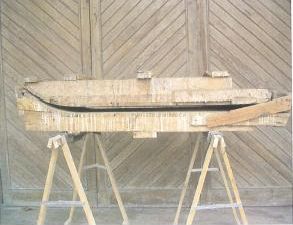 Linasazoro txanpero mould. Photo Lázaro Eizaguirre Echegaray and Mikel Berasategi Troitiño(2007). |
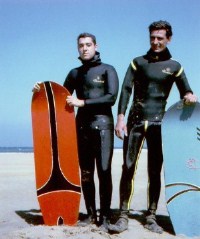 Manuel Martinez (Lolis) and Antonio Sáez, 1962. Photo courtesy of 'Meco'. |
James Morrsion wrote a journal while on the HMS Bounty, 1787-1792 wrote: "they get peices of Board of any length with which they swim out to the back of the surf, when they Watch the rise of a surf somtimes a Mile from the shore & laying their Breast on the board, keep themselves poised on the Surf so as to come in on the top of it, with amazing rapidity watching the time that it breaks, when they turn with great Activity and diving under the surge swim out again towing their plank with them ... some are so expert as to stand on their board till the Surf breaks".
Another account comes from Bowker and Bligh, 1789: "The use of inverted canoe paddles is confirmed by the method of "placing the broad part under the Belly holding the other end with their Arms". Such a technique was unlikely to be suitable in deep water and the paddles were probably used close to the beach".
For more details see: Surfresearch historical accounts
 Tahiti surfer. Photo Bud Browne. |
 Tahiti surfer. Photo from Margan , F and Finney B.R (1970). A Pictorial History of Surfing. |
Captain Phillipe Aubin, writing in 1756 noted: "Children aged twelve and fourteen have a unique game that would frighten a European. They choose a plain beach with no rocks; there, they will move together, each one having a plank in his hand, as wide as they can find, then they put their chest on the board ; then they abandon themselves to the wave. Others have a square board, about a foot wide, with a hole at each end through which they hold it. Then they advance as far as they like into the sea, all arranged in a row, and let themselves ride on the summit of the swells toward the beach: the wave is sometimes so high that for those spectators who look at them from the shore, their heads appear like black balls on a carpet of snow. I saw children having fun at the same exercise at the Bay of Bermuda, the Turks islands near Santo Domingo ...'. Source Surfresearch historical account This account was located by Hervé Manificat.
A 1956 publication, Patrick Ellam's The Sportsman's Guide to the Caribbean reports surfing at Maraccas Bay on Trinidad. In addition to directions, there is advice regarding getting a board made: " But first you call at a timber yard in town and get them to make you a board each. They use the short type there so that all you need is a 4-foot length of cedar or similar wood about 15 inches wide, not too heavy and rounded off at one end (the front).Any yard will make them for you in a few minutes while you wait and the usual charge is about 60 cents each, but make sure that they do not leave any rough edges or splinters".
Advice is also provided on how to ride the board: "Using a surf board the trick is to get started. In the beginning it is best to wade out to the first sand bar, where the water is no more than waist deep, face the beach and wait for a wave that is just about to break as it reaches you. Then you give a little jump and launch yourself down its steep front face, keeping the rear end of the board at your waist and the front end as flat on the surface of the water as you can without actually letting it go under. To avoid collisions with other bathers you can steer to a limited extent by tipping the board down on one side and as you get better at it you can start further out to get a longer ride, but be careful as the sea is definitely rough".
 Source: oldtimecalypso Youtube channel TIME OUT IN TRINIDAD- 1950s - Pt. 13 - Maracas Bay and North Coast Road |
 Source: Mypaipoboard website Patrick Ellam's The Sportsman's Guide to the Caribbean |
Tom Allan wrote a 2020 article on bodysurfing (viya) which has a long tradition in the Black Sea,at Rumeli Feneri. . One of those interviewed for this article was Mustafa Aytac. He reported that his father Mustakim who learned bodysurfing from his father,recalled small wooden boards being used in the surf. Bodysurfing moves included: "sülün, a long, weaving ride across the face of the wave (oddly, the word means “pheasant” in Turkish) and kabak, a short and brutal drop into the abyss, where you hope to avoid being smashed like a pumpkin (kabak) on the rocks. Osman’s signature move is a somersault performed halfway through the ride"
THE LOST SURFERS OF THE BLACK SEA
Viya Viya with a modern wooden board.
 Wooden boards. Photo courtesy of surfinginturkey@gmail.com |
Hawaii was a major influence on the development surfing on the US mainland. California, Oregon, Washington state, New Jersey and North Carolina were locations where bellyboards were identified as being used. Bellyboards featured in magazines, including articles on how you could make your own. Before the introduction of fibreglass bellyboards, there was transition from simple wooden boards to higher performance bellyboards. The latter were influenced by two different types of boards. One style of board, was the twin-finned Froiseth style board, which would be produced by people like Gordon Thiesz and gain popularity around Laguna Beach. The other style of board, is the low buoyancy finless Hawaiian paipo board, which led to the development of some early kneeboards, as well as to prone use. Jon Manns from Santa Cruz and Steve Lis from san Diego, started riding these thin paipo boards.
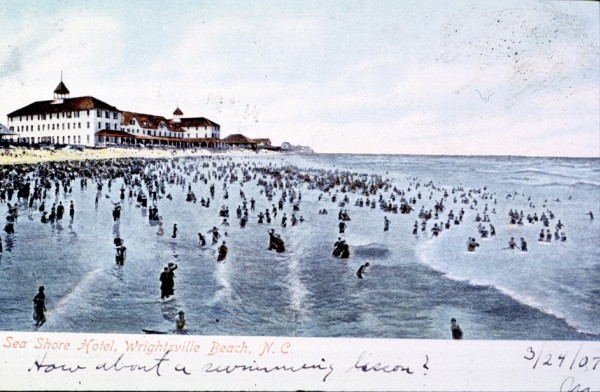 Wrightsville 1907. Photo Skip Funderburg. |
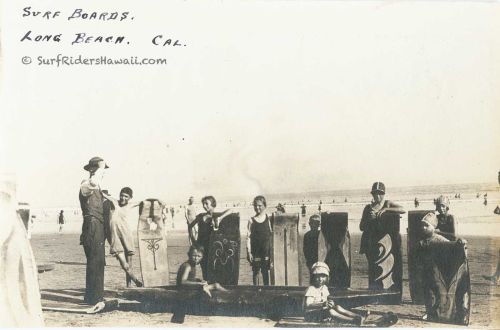 Hollow boards, 1910, LongBeach. These boards used in a local waterslide may also have been ridden in the surf. Photo courtesy Tim DeLaVega |
 Marshall bellyboards 1920s, LongBeach. |
 Surf Sled, Popular Science Monthly, June 1928. |
 Right- New Jersey, 1939. Photo Bart Tucker Left - 1940s board used by Jimmie. Photo Joelioski. |
 Dorothy Arnold poster, Universal Pictures 1938. |
A distinctive feature of bellyboard use in the US was the commercial production of boards, especially in the late 1960s and 1970s. California hosted a range of companies which featured the word "paipo" in this name: Newport Paipo, El Paipo, House of Paipo, Pacific Paipo Boards. Bellyboards were produced by a range of other shapers as well, such as Chuck Dent, Dave Sweet, Greek, Hansen, Petrillo, . The latter were often custom orders, while some of the larger companies, such as Dextra, Val Surf and Jeffrey Dale produced moulded boards. An attraction of bellyboards in California was the ability to surf in "Black ball" beaches, where surfboards were banned during certain times. The popularity of bellyboards during this time was also enhanced by numerous magazine articles. Lower cost boogieboards would soon however, take over the market.
 US serviceman 1942. Photo courtesy Tim DeLaVega |
 Lance Carson. Hollow bellyboard bult by his father, 1948. |
Interviews with US bellyboard riders Paipo interviews on mypaipoboards.org
Finned and finless boards have been ridden or made by Rick Boufford, Jeff Chamberlain, Gary Crandall, Larry Goddard, Wes Humpston, Jon Manss (like Steve Lis, Jon started riding his boards prone then as kneeboards), Don Long, Robert Moynier & Malcolm Campbell, Nels Norene, Larry O'Brien, Jeff Quam, Richard Safady, Mike Shourds and Tom Wegener.
In addition to Jon Manss from Santa Cruz, the Wedge was ridden by bellyboard riders such as Skip Briggs, Chuck Gardner and Ron Romanosky, who all became kneeboarders.
 Pat Curren. Twin fin bellyboard, 1950s. Photo Tom Keck. |
 Jon Manss. Paipo with fin and Mustang in background. |
 Newell, Skip. (1970, January/February).Surfing Action, 3(1), 56-59 |
 El Paipo board. |
 Chuck Dent and Newport paipo - 1960s. Source: My Paipo Boards and... More |
 Rick Newcombe (top) and Chuck Gardner. Surfer magazine, v10 n02, 1969. Reducing the Medium |
Last not least, from the US comes Rod Rodgers, whose Mypaipboards is a repository of all things related to paipo/bellyboards, including books, movies, magazine articles, jigsaws, interviews, manufacturers.
Swimming in the surf at Playa Brava gradually became popular after the Hotel Casino Nogaró was built on January 8, 1938. .
 Wooden boards, 1940s/50s. Photo courtesy of Museo del Surf, Montevideo. |
 Swimmers in Punta del Este. Excerpt from photo by Jeanne Mandello. |
Bellyboards and paipos may seem like a thing of the past, however, surfers in different locations around the world, continue to ride and have fun on these boards
This website was only possible because of the assistance of many people. Let me know if any photos are incorrectly attributed or used. Apologies to anyone I've left out. Many thanks to:
Australasia: Geoff Cater, Mike Brown, Gary Clist, Henry Marfleet, Ray Moran (Manly Surf museum), Bob Smith, John Burn and Phil Trigger. Also Dave Andrews, Dick Ash, Pete Berry, George Bills, Jeff Callaghan, Kit Carson, Lewis Cawsey, Brett Curtis,Tony Dawes, Paul Gannon, Bryan Hayden, Robert Hosking, Dr. Barry Hutchins, Dave Jackman, Peter Kidman, John Kovar, Joe Larkin, Kevin McManus, Dennis Markson, Ian Peden, Mick Potter, Barry Regan, Bob Rose , Dave Sams, Gordon Simpson, Pete Sobels, Col Taylor, Leigh Tingle and Paul Witzig. The Surfworld museums at Currumbin and Torquay have also been of assistance and are always worth a visit.
Britain: Matt Cooper, Emma Haylock, Henry Marfleet, Jeremy Oxenden, Sally Parkin, Charlie Spurr, Alex Williams. Also John Heath, Richard Whiting, Andy Bick and Keith Usher.
Continental Europe: Salva Artaza, Javier and Iñaki Arteche , Monique Beaufils, Jesús Belmonte "Sancheski", Antony 'Yep' Colas, Daniel Creignou, Gérard Decoster, Joserra de la Mar, Joël de Rosnay, Gibus de Soultrait, Olaf de Vries, Lázaro Echegaray Eizaguirre, Sergio Gonzalez Alonso, Alain Gonfaus Martinena, Borja Garmendia, Aitor Linaszoro, Brian Lowe, João Macdonald, Hervé Manificat, Jose Manuel Gutierrez "Meco", Pierre Mennesson, Antonio Muglia, Jem Oxenden, Florent Palangié, Arthur Pauli, Jean Pouyet, Gavin Randall, Guilhem Rainfray, Pete Robinson, Jacky Rott, Marlyn Souffront Tirado, Hugo Verlomme, Felip Verger, Phillipe Zibin and Andrés Zuberoa. >
Hawaii/US: John Clark, Tim DeLaVega , John Elwell, Hal Forsen, John Galera, Larry Goddard, Jim Growney, Richard Kenvin, Jarrett Liu, Dave Rochlen, Joel T. Smith, Tom Pohaku Stone , Stig Waidelich. Rick Boufford, Skip Briggs, Jeff Chamberlain, Gary Crandall, Chuck Gardner, Paul Gross, Wes Humpston, Jon Manss (like Steve Lis, Jon started riding his boards prone then as kneeboards), Don Long, John Mellor, Robert Moynier & Malcolm Campbell, Nels Norene, Larry O'Brien, Jeff Quam, Ron Romanosky, Richard Safady, Mike Shourds and Tom Wegener.
Japan: Nobuhito"Nobby" Ohkawa
Pacific: John Clark, David Herdrich and Geoff Cater.
South America: Reinaldo Andraus, Moraes Teixeira Filho, Otavio Pacheco, Luiz "Ted" Pereira, Tit Rosemberg, Edwin Salem.
Rod Rodgers has collaborated on paipo interviews and research over many years. John Milliken has provided invaluable assistance in providing guidance in creating web-pages and Glenn Stone wrote the R code to create the map.